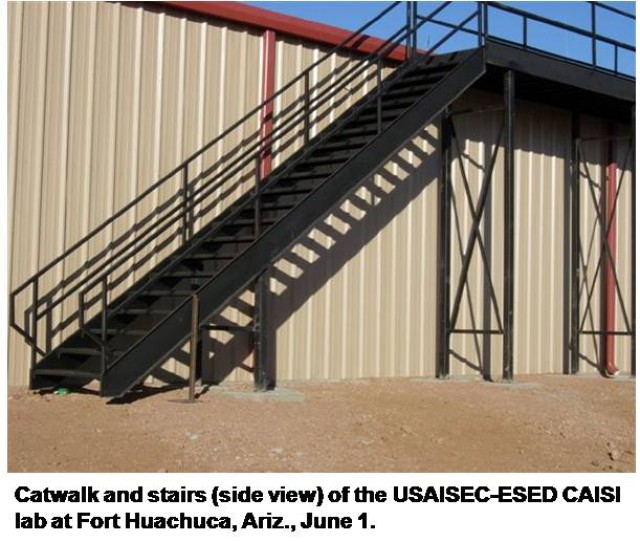FORT HUACHUCA, Ariz. - A $750,000 state-of-the art lab has finished construction to provide more space for testing and provide a work area in which radio frequency was controllable.
The completed Combat Service Support Automated Information Systems Interface lab will allow capability for battlefield Combat Service Support, or CSS, automation devices to exchange information electronically in a networked environment. The CAISI is a wireless interface that plugs the system into a local area network, or to a wide area network.
The CAISI team at Fort Huachuca was anxious to move into the new CAISI lab.
"I was excited to move to the new CAISI lab. This lab has a lot more room with individual cubicles as well as wall lockers. We have a lot more room for testing,Aca,!A? said Harp.
Six U.S. Army Information Systems Engineering Command engineers and a computer scientist have been selected to work at the lab a part of the USAISEC Enterprise Systems Engineering Directorate. In preparation for the new lab, this team of engineers attended a series of training sessions throughout the U.S. to assess and evaluate training materials. Team members include: Clyde Roark, systems engineer; Tanya Renteria, computer scientist; Richard Sinclair, systems engineer; Mike Chasse, systems engineer; Brad Amon, project manager; and Rodney Harp, electronics engineer.
During one of the training sessions, Harp provided systems engineering support during a regional Army National Guard training event where Soldiers from Nebraska, Colorado, and Wyoming attended the standard CAISI 2.0 course for the Operators class and the Service Support Representative class. Representatives from the National Guard Bureau office in Washington, D.C., were also in attendance.
Harp and Chasse recently returned from Phoenix where they provided engineering support to the Arizona National Guard McDowell FacilityAca,!a,,cs logistics branch during an exercise. They provided served as an information resource and resolved troubleshooting issues for the Combat System Support Automation Management Office.
CAISI and Combat Service Support Very Small Aperture Terminal (CSS VSAT) equipment were used with Standard Army Maintenance System - Enhanced; Transportation Coordinators' - Automated Information for Movement System; Standard Army Ammunition System, and Unit Level Logistics Systems - Aviation Enhanced (ULLS-AE). The National Guard (NG) is planning on setting up an on-going training site at the Regional Training Institute in Phoenix.
The CSS VSAT satellite communications network was tested at the National Training Center at Fort Irwin, Calif.; the 3rd Infantry Division at Fort Stewart, Ga,; and presently being tested in Kuwait as part of an Iraq deployment.
The combination of CSS VSAT and the CAISI increases Soldier readiness by giving CSS Soldiers in the field the ability to electronically transmit supply requisitions and receive near-real time status reports on their orders, 24-hours-a day, seven-days-a-week.
The CSS VSAT/CAISI was fielded with the 3rd Infantry Division by the Product Manager for Defense Wide Transmission Systems in conjunction with Project Manager, Defense Communications and Army Transmission Systems.
This endeavor enhances force protection by reducing the need for travel convoys to hand deliver detailed and sensitive logistical orders, meetings and information. Via the CSS VSAT/CAISI, Soldiers can conduct these tasks virtually, thus greatly reducing their risk of being ambushed during a travel convoy to achieve the same task.


Social Sharing